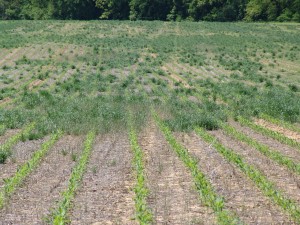
Several corn fields had ryegrass escape glyphosate + dicamba early burndown. These fields were then retreated with paraquat + atrazine or glyphosate + atrazine at planting that also did not provide good control (picture right). The time to control ryegrass is prior to planting. The most consistent way to control it is sequential paraquat applications spaced about 10 days apart.
There have been several questions about what to do with this existing ryegrass in emerged corn. Unfortunately, the only answer that has the potential to provide good control is a chopping crew. My colleague with Mississippi State University, Dr. Jason Bond has done as much work as anyone on this weed and he tells me that herbicides like Accent or Steadfast will at best provide about 40 to 60% control and possibly cut down on seed production. Other herbicides like Capreno or Halex GT will perform no better. According to his data, Liberty would probably provide the most robust suppression of any herbicide options available (65%). Just based on my experience utilizing Liberty plus atrazine tankmixes, I would expect that tankmix to provide better control than Liberty alone. Of course, this Liberty option assumes that the corn is Liberty Link. Jason’s last statement to me was to advise growers with this problem to make sure the other weeds in these corn fields are controlled so they do not pile on to the competition that is occurring from the ryegrass.


I’ve been fighting ryegrass in corn for 30 years. It’s a tough customer.
I haven’t had much luck with the 2x paraquat approach unless the first application is made when the ryegrass is pretty small, about 4″ or less. It might work on bigger ryegrass if you use enough water and paraquat. The second application has to be made just as the stuff starts to green up after the initial burndown. If it’s not yet time to plant, you can’t wait until planting and make the second application then. It won’t work. Been there, done that, got lots of ryegrass.
I’ve had decent luck with Accent, but I haven’t used it a lot. It seemed to me that it pretty much took the ryegrass out of competition with the corn even if it did not kill all of it.
It also seems to me that the effectiveness of glyphosate on ryegrass is highly temperature dependent, perhaps even more so than with most other weeds. If the corn is glyphosate tolerant, one might get decent results with glyphosate over the top during a hot spell even if it did not work in cooler temps earlier. Unfortunately, high temps look to be in short supply for the next week.
The most important thing I have learned over my 30 year battle with ryegrass is that you have to go after it every chance you get, all through the rotation. Don’t ever let it produce seed if you can help it, which means controlling it in wheat even when it is not present in a quantity that would cause significant yield loss in the wheat. (My apologies to the IPM folks, but the economic damage from light infestations of ryegrass is very real–it just doesn’t show up in the wheat yield.) It also means making sure ryegrass doesn’t make seed before a late planted bean crop.
One final suggestion: Try clethodim + dicamba instead of glyphosate + dicamba for early burndown. If you try this be sure you comply with the waiting period (15 days, I think) before planting corn after applying clethodim. I have found clethodim to be much more efective on ryegrass in the cool temps of late February and March than glyphosate. Clethodim is SLOW, but it works, and even if it doesn’t completely kill a few plants, they tend to be susceptible to either paraquat or glyphosate applied at planting.
Good luck,
Stephen Worley, Hampshire, TN
Stephen
Thanks for the comment. I aggree the ryegrass we have been working with is very temperature sensistive to glyphosate. However, there is a new biotype first reported in Mississippi that is completely resistant to glyphosate. I feel we are seeing pop up in some fields in West TN. On top of that the ALS inhibitors herbicides, like Accent, are also not effective. We are seeing that now in West TN in wheat where Osprey/Powerflex do not provide good control. That pretty much leaves paraquat as the last resort when planting time
thanks
Larry
Sounds like you really do have a monster there in West Tennessee. The regular stuff we have here in middle TN is bad enough.
One other thought: Our ryegrass problems got much worse when we switched to group IV beans for doublecropping instead of group V. This was in the mid-80’s. Later maturing beans don’t prevent ryegrass, but they generally delay germination which makes the ryegrass smaller and easier to kill with paraquat in the spring. Later maturing beans might be worth considering for future years. Here in the outer Central Basin, the risk from early fall frost is too great, but a lot of W. TN is warmer than we are here.
Try to keep this resistant ryegrass in W. TN if you can.
Thanks,
Stephen